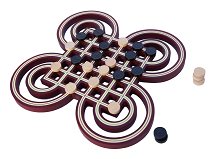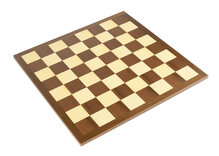The Rules of Draughts
The game of Draughts goes by a variety of different names and has several different variations. The game given first is English Draughts which is known as Checkers in North America. Also given is Polish Draughts, which is played all over Western Europe and which is the most commonly played version of the game in International competition.
See also: Draughts / Checkers.
Draughts or Checkers
Equipment
The game of Draughts is played on a standard Chess board 64 black and white chequered squares. Each player has 12 pieces normally in the form of fat round counters. The real shades of the pieces and the board do not necessarily need to be black and white but they are normally referred to as black and white, regardless. The board is placed between the two opponents so that the near right-hand corner square is white for both players (in the same way as for Chess).
Preparation and Objective
Black always plays first. A coin is tossed to decide which player will be black. Each player's pieces are placed on the 12 black squares nearest to that player. The white squares are not used at all in the game - the pieces only move diagonally and so stay on the black squares throughout. The objective of the game is to take all of the opponent's pieces or to produce a position such that the opponent is unable to move.
Play
Players take turns to move a piece of their own colour. Any piece that reaches the far edge of the board is immediately crowned and is thereafter known as a "King". The act of crowning is a physical one - another piece of the same shade is placed on top of the piece in order to distinguish it from an ordinary piece. Until a piece is "crowned", it can only move and capture in a diagonally forwards direction. Kings are allowed to move and capture diagonally forwards and backwards and are consequently more powerful and valuable than ordinary pieces. However, ordinary pieces can capture Kings. Whenever a piece has an opponent's piece adjacent to it and the square immediately beyond the opponent's piece is vacant, the opponent's piece can be captured. If the player has the opportunity to capture one or more of the opponent's pieces, then the player must do so. A piece is taken by simply hopping over it into the vacant square beyond and removing it from the board. Unlike an ordinary move, a capturing move can consist of several such hops - if a piece takes an opponent's piece and the new position allows it to take another piece, then it must do so straight away. The move finishes only when the position of the capturing piece no longer allows it to taken any more pieces or when an uncrowned piece arrives at the far edge of the board and is crowned. If more than one piece can capture, then the player is entirely free to choose which of those pieces to move. Likewise, if a capturing piece is able to capture in more than one direction, the player is free to choose which direction to move in. i.e. it is not compulsory to move the piece or take the route that will result in the maximum number of captures. If no capturing moves are available, then an ordinary move is made by moving a piece one square diagonally. In the past, the "huffing" rule was used. For this, if a player noticed that the opponent had failed to capture when the option was open (even if the offending piece had already captured one or more pieces that turn), the player can huff the offending piece before the next move is made and it is removed from the board. Nowadays, this rule is rarely used. Instead a player just points out the error and the opponent is forced to make the correct move.
Finishing
The game is won by the player who first manages to take all his opponent's pieces or renders them unable to move. A draw occurs by agreement at any point during the game. If a player refuses the offer of a draw, that player is required to force a win or show a decided advantage within 40 of that players own moves from that point. Draws are fairly common in the game of draughts - especially at the top level of the game.
Polish Draughts
Equipment
Polish Draughts is played on a 10 x 10 chequered board with 20 black pieces and 20 white pieces. The pieces start on the black squares of the four rows nearest to the players.
Play
The game is played in a similar fashion to English Draughts but the pieces move and capture in an extended fashion. Crowned pieces are called Queens. The following are the additional rules:
- Un-crowned pieces can only move diagonally forwards but can capture diagonally forwards AND backwards.
- A Queen moves by diagonally traversing any number of unoccupied squares. Likewise, when capturing, a Queen can travel over any number of unoccupied squares before and after hopping the piece.
- Capturing is compulsory and where there is a choice, the move that captures the greatest number of pieces must be made.
- Captured pieces are not removed from the board until the end of a move. Any pieces which have been captured but not yet removed cannot be hopped over again during the course of the move - dead pieces form an impassable barrier.
- A piece is only crowned if the piece finishes the move on the final square. So, if a piece moves onto and off the final row during the course of a capturing move, and does not finish on the final row, it is not crowned.
Competitions
In competitions, to reduce the chance of draws and make the opening moves less predictable, a "three-move ballot" scheme is usually adopted. A number of opening sequences of three moves are written on cards and a card is selected at random to start the game. The game then proceeds with white playing the fourth move. Once the game is finished, players swap sides and play a second game with the same starting card. The player who achieves the best result over the pair of games is the winner.
These rules are provided by Masters Traditional Games, an Internet shop selling quality traditional games, pub games and unusual games. For general information or for copying and copyright, see our Rules Information page.
Our rules are comprehensive instructions for friendly play. If in doubt, always abide by locally-played or house rules.
Copyright James Masters, 2025. All rights reserved.









































